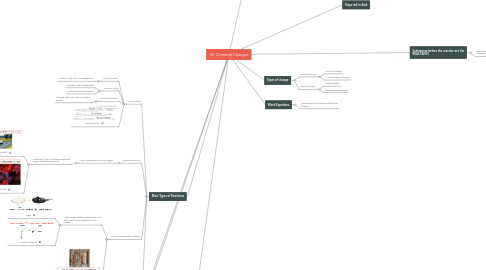
1. Reactions with Electricity
1.1. Electrolysis
2. Mass of reactants = Mass of products
3. Main Types of Reactions
3.1. Acid Reactions
3.1.1. Acids and Metals
3.1.1.1. Produces Metal Salt and Hydrogen Gas
3.1.2. Acids and Alkalli
3.1.2.1. Produces Metal Salt and water
3.1.2.2. Called Neutralisation Reaction
3.1.3. Acid and Carbonate
3.1.3.1. Produces Metal Salt, Water and Carbon Dioxide
3.1.4. Naming the Salt
3.2. Oxidation Reactions
3.2.1. When a substance reacts with Oxygen
3.2.1.1. Combustion (When a substance reacts with Oxygen and heat is produced)
3.2.1.1.1. Combustion of Petrol
3.2.1.1.2. Combustion of Coal
3.3. Thermal Decomposition Reactions
3.3.1. When a single substance breaks down into two or more simpler substances when heated
3.3.1.1. Sugar
3.3.1.2. Copper Carbonate
3.3.2. Metal with Oxygen to form metal Oxide (Rusting)
3.4. Reactions with Light
3.4.1. Photosynthesis
4. Particulate Model
4.1. Number of atoms of reactants = Number of Atoms of products
5. Stays red in Acid
6. Substances before the reaction are the REACTANTS
6.1. Substances after the reaction are the PRODUCTS
7. Acid and Alkali
7.1. Acids
7.1.1. Sour Taste
7.1.2. pH value < 7
7.1.3. hydrochloric acid, sulfuric acid and nitric acid
7.1.4. Found in vinegar, soft drinks and citrus fruits like oranges and lemons
7.2. Alkalis
7.2.1. Bitter Taste
7.2.2. pH value > 7
7.2.3. Metal Hydroxides
7.2.3.1. Sodium Hydroxide
7.2.3.2. Potassium Hydroxide
7.2.3.3. Magnesium Hydroxide
7.2.4. Found in soap, detergent, lime water (slaked lime)
7.3. Indicators
7.3.1. Red litmus paper
7.3.1.1. Turns blue in Alkali
7.3.2. Blue litmus paper
7.3.2.1. Turns Red in Acid
7.3.2.2. Stays blue in Alkali
7.3.3. Universal Indicator
8. Types of change
8.1. Chemical Change
8.1.1. mostly Irreversible
8.1.2. A new substance is formed
8.2. Physical Change
8.2.1. mostly reversible
8.2.2. No new substance formed
